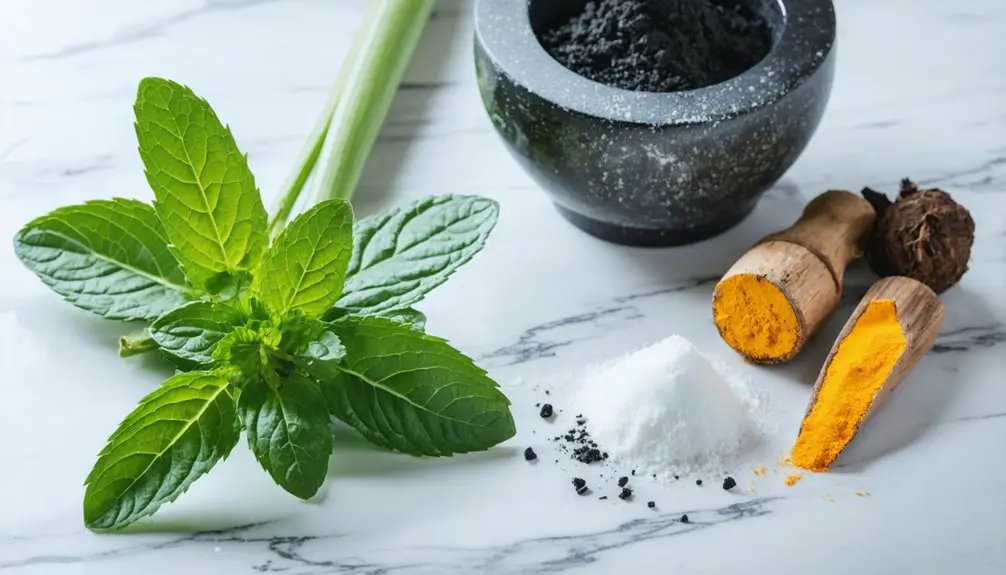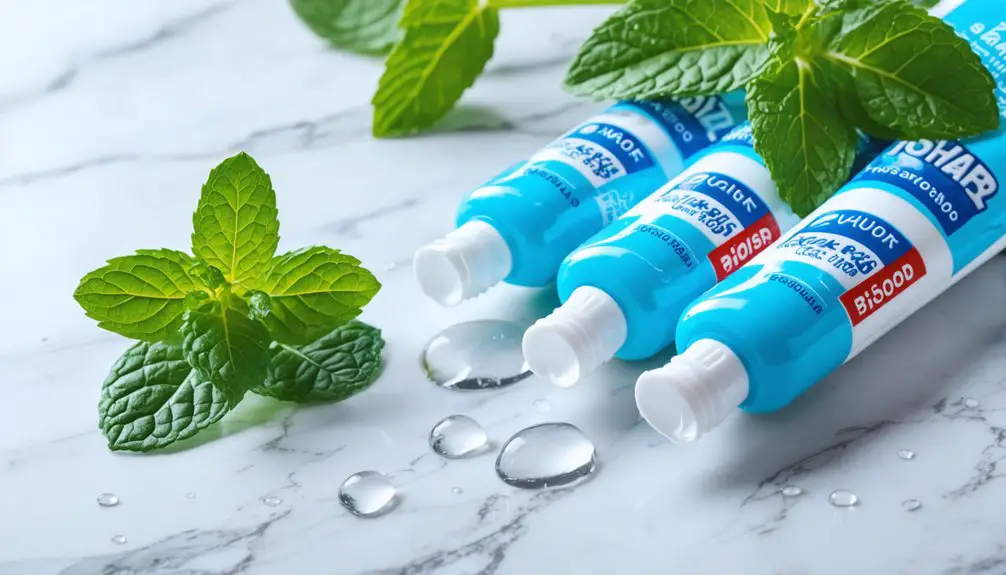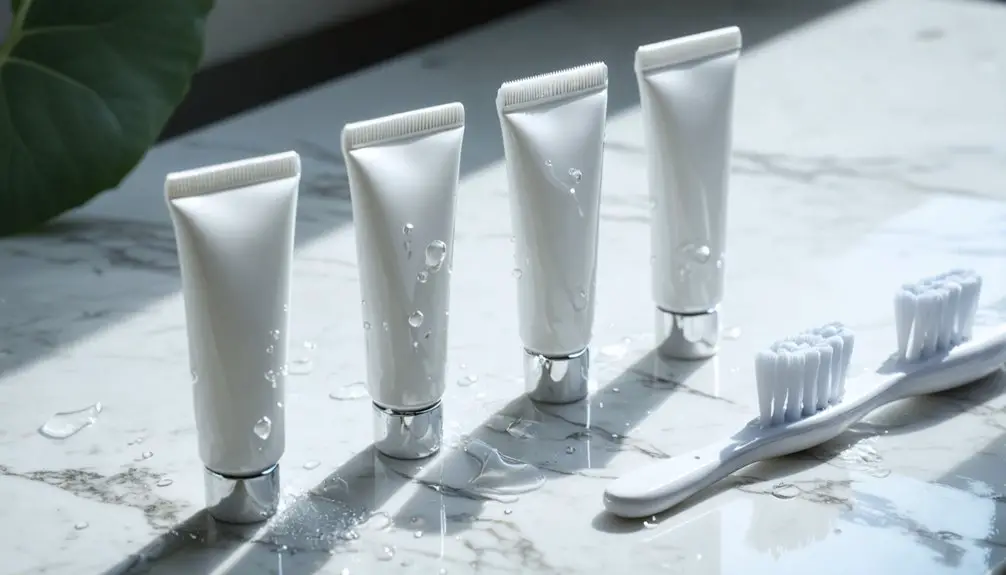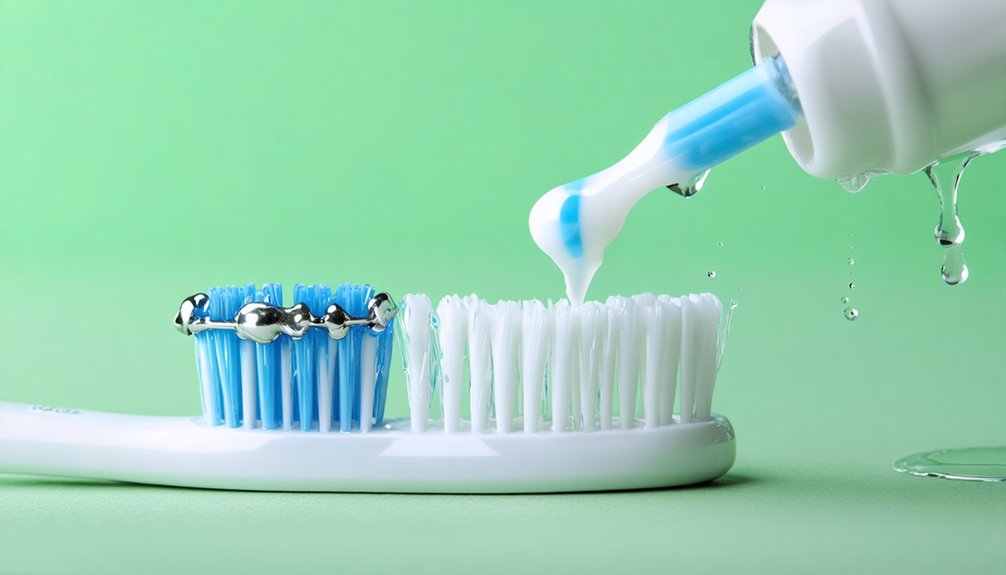You’ll find several effective natural whitening ingredients in modern toothpaste formulations. Enzymatic cleaners like papain and bromelain target protein-based stains, while hydroxyapatite mimics natural enamel for deep restoration. Gentle abrasives such as hydrated silica and calcium carbonate provide safe polishing action. Plant-based extracts and minerals offer gradual improvement without harsh chemicals. Understanding these ingredients’ specific roles can help you choose the most suitable natural whitening solution for your needs.
Key Takeaways
- Hydroxyapatite mimics natural tooth enamel and penetrates deeply into cracks for effective whitening while promoting remineralization.
- Papain from papaya and bromelain from pineapple serve as enzymatic cleaners that naturally remove protein-based stains.
- Gentle abrasives like hydrated silica and calcium carbonate safely remove surface stains while strengthening tooth enamel.
- Natural plant extracts like coconut oil provide antimicrobial whitening benefits without harsh chemicals or sensitivity issues.
- Combining mineral-based solutions with plant-based ingredients creates effective, enamel-safe whitening formulations for long-term oral health.
Understanding Natural Whitening Ingredients in Modern Toothpaste
As consumers increasingly seek natural alternatives to conventional oral care products, understanding the active ingredients in modern whitening toothpaste has become essential.
You’ll find that natural whitening ingredients like papain from papaya and bromelain from pineapple work as enzymatic cleaners to break down protein-based stains. These combine with gentle abrasives such as hydrated silica and baking soda to polish your teeth effectively. Regular brushing with these ingredients can lead to gradual improvement in tooth brightness. Some popular natural toothpaste brands like Tom’s of Maine effectively whiten teeth with natural ingredients.
The ingredient synergy in modern natural toothpaste formulations maximizes effectiveness while minimizing enamel wear. For instance, coconut oil’s antibacterial properties complement almond shell extract’s polishing action, while tea tree oil and cinnamon provide antimicrobial benefits.
When choosing a natural whitening toothpaste, look for products that combine these ingredients with sustainable packaging and avoid artificial additives for best results.
The Science Behind Hydroxyapatite for Teeth Whitening
You’ll find that hydroxyapatite’s molecular structure closely mimics your natural tooth enamel, allowing it to effectively fill microscopic defects and restore mineralization.
Clinical studies demonstrate that nano-hydroxyapatite particles penetrate deeper into enamel cracks, providing superior remineralization compared to traditional whitening agents. Regular use supports healthy oral microbiome maintenance and gum health while whitening teeth.
As a biocompatible mineral naturally present in your teeth, hydroxyapatite offers a safe alternative to fluoride while delivering proven whitening results through enhanced surface reflection and stain removal. The mineral compound creates a gentle whitening effect by smoothing the tooth surface rather than using harsh oxidizing agents found in peroxide-based products.
Molecular Structure and Function
While many natural whitening ingredients work primarily through abrasion, hydroxyapatite (HAP) stands out for its unique molecular structure and biomimetic properties.
You’ll find HAP’s chemical formula, Ca₅(PO₄)₃OH, mirrors the primary mineral component in your natural tooth enamel, comprising about 70% of bone structure.
The crystalline lattice of HAP enables essential molecular interactions that support your teeth’s structural integrity.
When applied in nano-form, these particles penetrate deeper into enamel micro-cracks, facilitating biomimetic remineralization.
Used extensively in clinical settings since the 1970s, bone and dental repair demonstrates HAP’s proven effectiveness.
They’ll fill demineralized patches while creating strong adhesion to tooth surfaces.
Unlike harsh abrasives, HAP’s structure allows it to polish stains gently while rebuilding enamel thickness.
This dual action results in both immediate whitening and long-term strengthening of your teeth’s protective layer.
Clinical Studies Show Results
Recent systematic reviews encompassing 17 clinical studies have established hydroxyapatite’s effectiveness in teeth whitening, with particularly strong evidence from laboratory investigations.
You’ll find that nano-hydroxyapatite delivers enhanced results by improving enamel remineralization and surface coverage, leading to better stain removal and color uniformity. NASA scientists pioneered the early research of hydroxyapatite for dental applications in the 1970s.
Clinical implications suggest hydroxyapatite works differently than traditional bleaching agents. It whitens teeth by replenishing minerals and creating a smoother, more reflective surface while simultaneously strengthening your enamel.
Unlike peroxide-based products, it won’t cause sensitivity. Studies show 2% n-HA significantly reduces tooth sensitivity compared to standard bleaching treatments. Future research through large-scale randomized controlled trials will further validate these findings, though current evidence already demonstrates hydroxyapatite’s dual benefits of gentle whitening and therapeutic oral health support.
Safe Alternative to Fluoride
As scientific understanding of oral health advances, hydroxyapatite has emerged as a groundbreaking fluoride alternative in natural toothpaste formulations.
If you’re seeking to address fluoride concerns while maintaining ideal enamel health, hydroxyapatite offers a safe, biocompatible solution that mimics your teeth’s natural mineral composition. Originally developed by NASA in 1970, this innovative ingredient continues to revolutionize dental care. The mineral makes up 80% of teeth and provides natural resilience against damage.
- Rebuilds enamel structure by filling microscopic defects with nano-sized particles
- Provides natural whitening through mineral restoration rather than harsh bleaching
- Contains no toxic ingredients, making it safe for all ages including children
- Reduces sensitivity while supporting long-term tooth strength
This revolutionary ingredient works differently than fluoride by actually reconstructing your enamel rather than just hardening it.
Combined with complementary natural ingredients like xylitol and essential oils, hydroxyapatite delivers thorough oral care without the risks associated with traditional fluoride formulations.
Popular Herbal Components and Their Whitening Effects
Natural tooth whitening relies heavily on enzymatic components derived from common fruits and plants.
You’ll find powerful whitening enzymes in pineapple’s bromelain and papaya’s papain, which effectively break down protein-based stains on tooth enamel. Unripe papaya offers even stronger herbal benefits due to its higher enzyme concentration.
Kiwifruit contributes actinidin, another enzyme that targets surface stains through chemical rather than abrasive action. Combining these fruits with crunchy vegetables like carrots and celery can enhance natural cleaning effects.
These natural enzymes work gently yet effectively, minimizing risks to enamel integrity compared to harsh bleaching agents. Clinical studies support the inclusion of bromelain and papain in tooth-whitening formulations, demonstrating their ability to deliver noticeable results.
When seeking natural whitening solutions, these fruit-derived enzymes offer a scientifically-backed approach to achieving a brighter smile.
Safe Alternatives to Traditional Whitening Agents

You’ll find that gentle plant extracts like coconut oil provide effective natural whitening through antimicrobial action rather than harsh abrasives or chemicals.
Natural minerals, particularly baking soda, offer a safe alternative to traditional bleaching agents when used in moderation as part of your oral care routine.
While activated charcoal has gained popularity, you should limit its use to twice weekly and combine it with other proven natural brighteners for best results without risking enamel damage.
Gentle Whitening Plant Extracts
When seeking gentler alternatives to traditional teeth whitening agents, plant-based extracts offer effective solutions through their natural enzymes and compounds. Through gentle enzymatic action, these ingredients effectively break down stains while preserving your enamel’s integrity.
Key plant extracts for natural stain removal include:
- Papain from papaya and bromelain from pineapple, which break down plaque films and surface stains
- Actinidin from kiwifruit, which targets enamel discoloration through specialized enzyme activity
- Malic acid-rich fruits like strawberries and apples that naturally whiten while stimulating protective saliva
- Rosella flower petals, containing vitamins and minerals that bind to stains while supporting oral health
These botanical ingredients work synergistically to brighten your smile while maintaining peak dental wellness.
Mineral-Based Brightening Solutions
Building on the power of plant-based ingredients, mineral-based brightening solutions offer another scientifically proven approach to natural teeth whitening.
You’ll find innovative options like hydroxyapatite, a biomimetic mineral that repairs and whitens by depositing white particles on your enamel while supporting remineralization.
For gentle cleaning, calcium-based mineral abrasives like calcium carbonate and calcium peroxide provide dual benefits of stain removal and enamel strengthening.
Hydrated silica serves as a mild natural abrasive that effectively removes surface stains without compromising enamel integrity.
The advanced PAP+ system combines non-peroxide whitening with nano-hydroxyapatite and potassium citrate, offering a sensitivity-free brightening experience while maintaining ideal oral pH balance.
Balancing Effectiveness With Enamel Protection
Achieving effective teeth whitening while preserving enamel integrity requires careful consideration of natural ingredients and their potential impacts.
When evaluating natural ingredient effectiveness, you’ll need to balance whitening goals with enamel protection strategies to guarantee long-term oral health.
- Baking soda offers gentler abrasion compared to activated charcoal, making it a safer choice for regular use in your natural whitening routine.
- Combining natural whiteners with fluoride or calcium-based remineralizing agents helps maintain enamel strength while pursuing stain removal.
- Regular dental check-ups allow you to monitor enamel wear when incorporating natural whitening ingredients into your oral care regimen.
- You’ll achieve ideal results by using natural abrasives in moderation and incorporating protective ingredients that support enamel mineralization.
Top Natural Brands and Their Unique Formulations

Several leading natural toothpaste brands have developed unique formulations that combine traditional ingredients with innovative whitening agents.
You’ll find RADIUS Organic and Wildist incorporating natural enzymes and botanical extracts, while Dr. Bronner’s relies on baking soda for gentle whitening. These brands prioritize eco-friendly packaging and sustainable practices.
Auromere stands out with its complex blend of herbal ingredients from Ayurvedic tradition, including neem and pomegranate rind.
For those seeking advanced enamel protection, Wellnesse’s hydroxyapatite formula offers clinically validated results comparable to fluoride.
Each brand demonstrates a commitment to natural whitening through different approaches – from Wildist’s activated charcoal to RADIUS’s enzyme-based system.
These formulations provide you with effective alternatives to conventional whitening toothpastes while maintaining strict environmental and ethical standards.
Combining Natural Methods for Enhanced Results
While individual natural whitening methods can be effective, combining specific techniques can amplify your results when done correctly.
The key to successful natural combinations lies in understanding which ingredients work synergistically to enhance whitening efficacy while maintaining dental health.
- Combine baking soda with diluted hydrogen peroxide 1-2 times weekly for gentle yet effective surface stain removal.
- Practice oil pulling with coconut oil, followed by a natural baking soda paste for enhanced plaque reduction.
- Use activated charcoal with baking soda sparingly, ensuring thorough rinsing to prevent residue buildup.
- Mix crushed strawberries with baking soda occasionally, always following with fluoride toothpaste.
Remember to avoid highly acidic combinations like lemon juice with baking soda, as these can damage your enamel despite temporary whitening effects.
Safety Guidelines and Best Practices for Natural Whitening
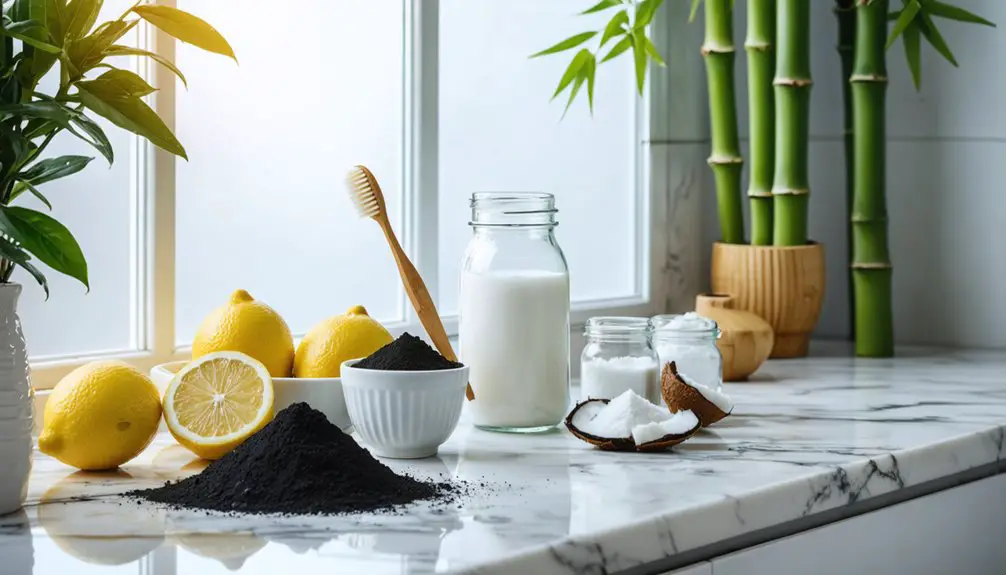
Natural teeth whitening requires careful attention to safety protocols and proper technique to avoid damaging your oral health.
Safe and effective natural teeth whitening depends on following proper protocols to preserve your smile while achieving brighter results.
When exploring natural whitening methods, you’ll need to avoid harsh ingredients like high-concentration peroxide, baking soda, or acidic substances that can erode your enamel. Always verify product safety by checking for ADA approval and “enamel safe” labeling.
Before starting any natural whitening regimen, consult your dental professional to assess your oral health and receive personalized guidance.
Stick to recommended application times and frequencies, and stop immediately if you experience sensitivity or discomfort.
To protect your gums, prevent prolonged contact with whitening agents, and consider using desensitizing products during treatment.
Remember that even natural ingredients require careful handling to maintain your dental health while achieving desired results.
Frequently Asked Questions
How Long Does It Take to See Results With Natural Whitening Toothpaste?
Over 85% of users see initial changes within 2-4 weeks. You’ll notice your whitening timeline varies based on ingredient effectiveness, with more significant results appearing between 6-8 weeks of consistent daily use.
Can Natural Whitening Ingredients Remove Deep-Set Stains From Medications?
You won’t effectively remove deep-set stains from medication effects using natural whitening ingredients alone. These stains are embedded within your tooth structure and typically require professional treatments for significant improvement.
Are Natural Whitening Toothpastes Safe During Pregnancy?
While you’re already juggling pregnancy cravings, you’ll be glad to know natural whitening toothpastes using baking soda or nano hydroxyapatite are generally safe. Avoid peroxide-based products due to ingredient concerns.
How Often Should I Replace My Natural Toothpaste to Maintain Effectiveness?
You’ll need to replace your natural toothpaste every 2-3 months to maintain ingredient potency. Don’t exceed the 1-2 year shelf life, and replace sooner if you notice changes in texture or smell.
Can I Use Natural Whitening Toothpaste With Dental Crowns or Veneers?
You shouldn’t use whitening toothpaste on crowns or veneers, as it can damage their surface. For natural crown care and veneer maintenance, choose gentle, non-abrasive toothpaste specifically formulated for restorations.
References
- https://pmc.ncbi.nlm.nih.gov/articles/PMC6369603/
- https://dentistofredmond.com/best-teeth-whitening-toothpaste-guide/
- https://www.pleasantfamilydentistry.com/blog/6-natural-ways-to-whiten-your-teeth
- https://davids-usa.com
- https://wellnesse.com/products/toothpaste
- https://www.womenshealthmag.com/beauty/g26031480/best-natural-toothpastes/
- https://www.goodrx.com/conditions/dental-care/best-whitening-toothpaste
- https://drjennatural.com/collections/all-products
- https://www.trysnow.com/blogs/news/does-hydroxyapatite-whiten-teeth
- https://betterbiom.com/blogs/learn/does-hydroxyapatite-whiten-teeth
